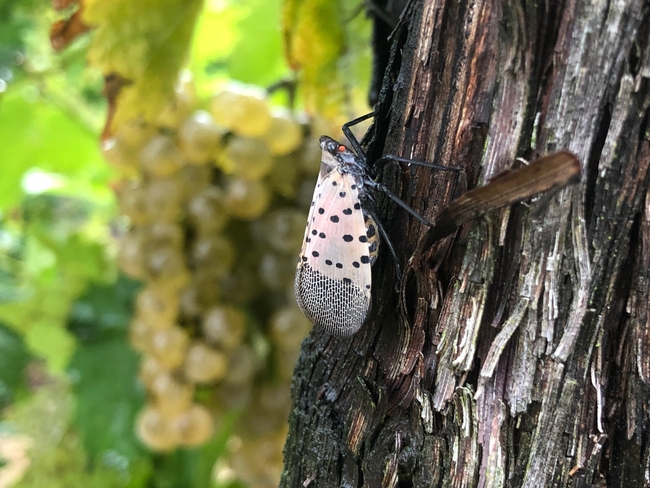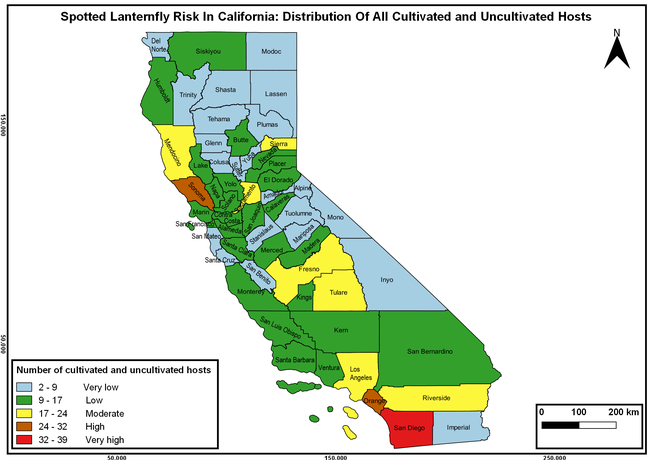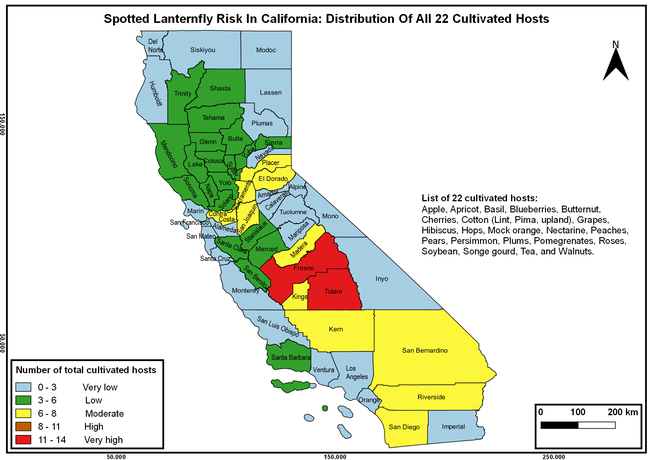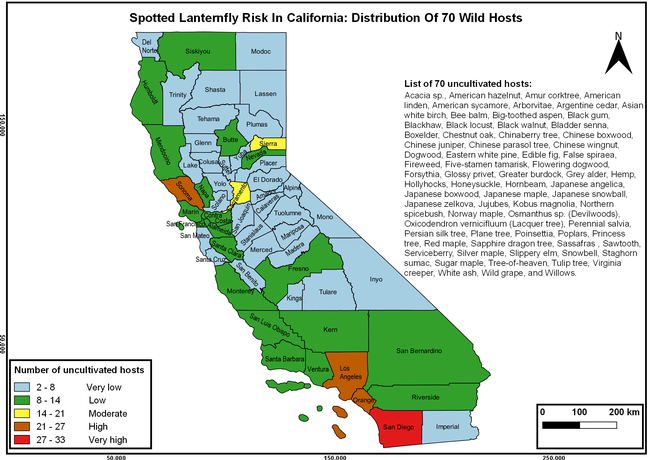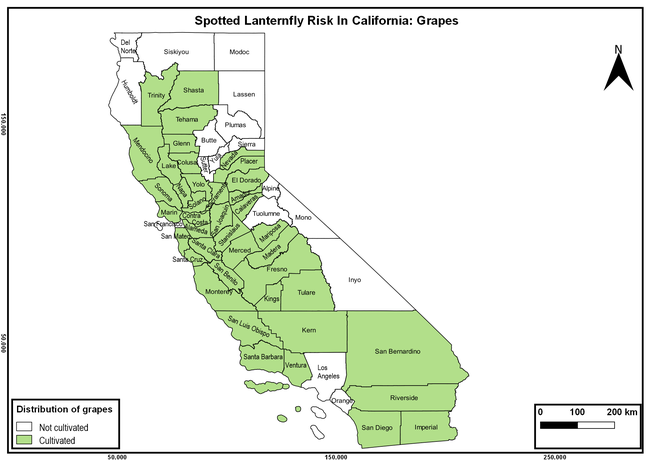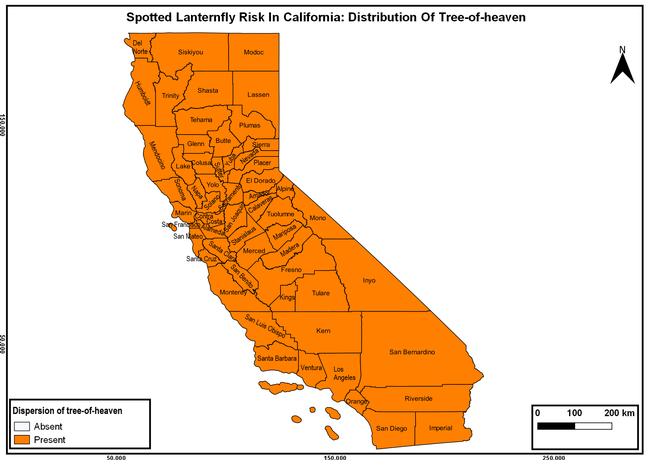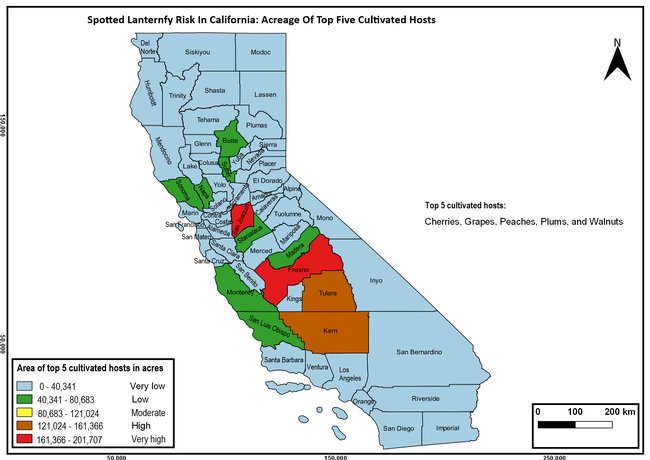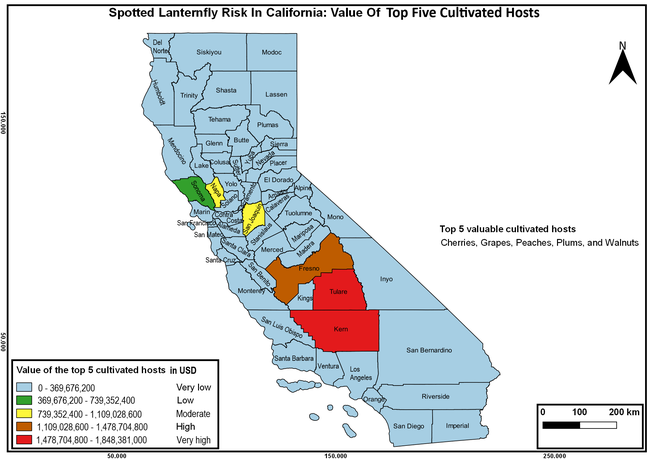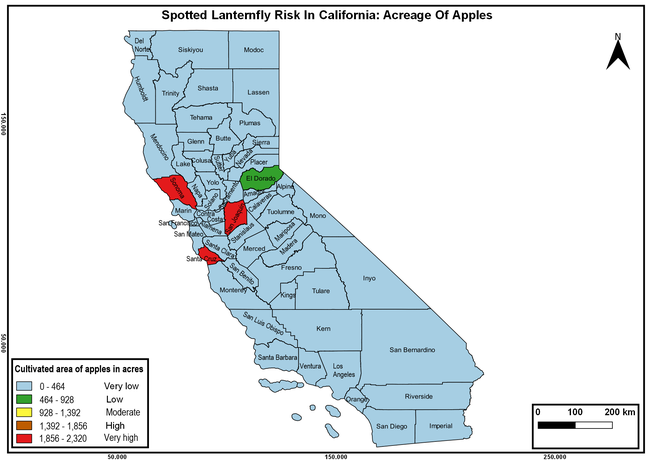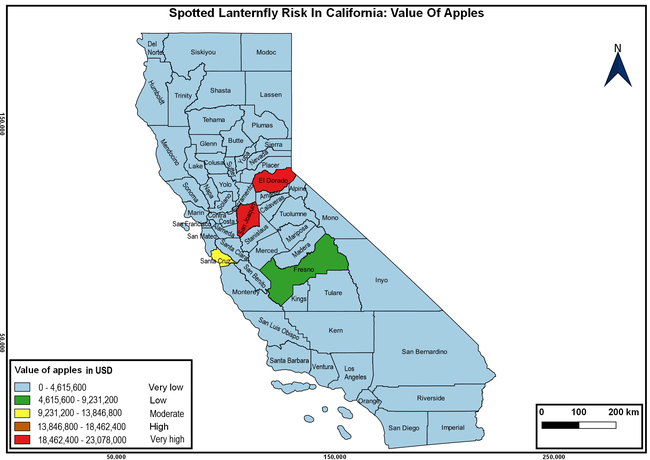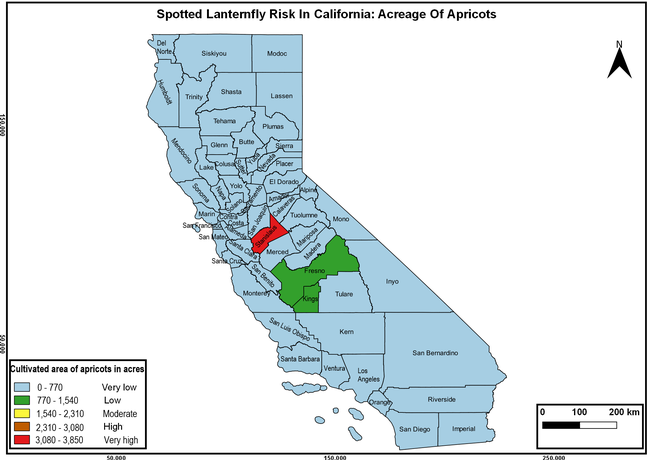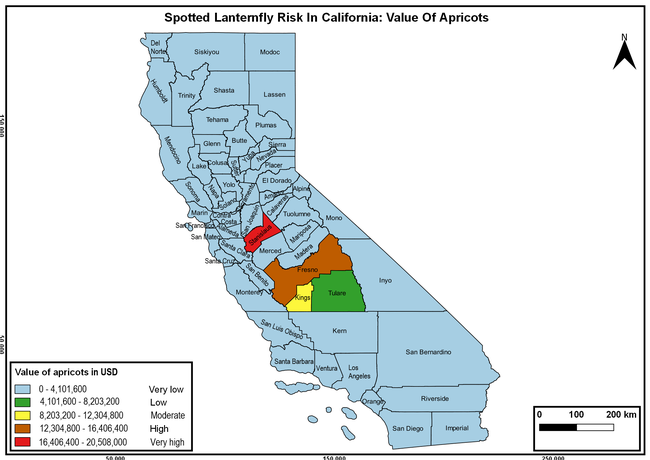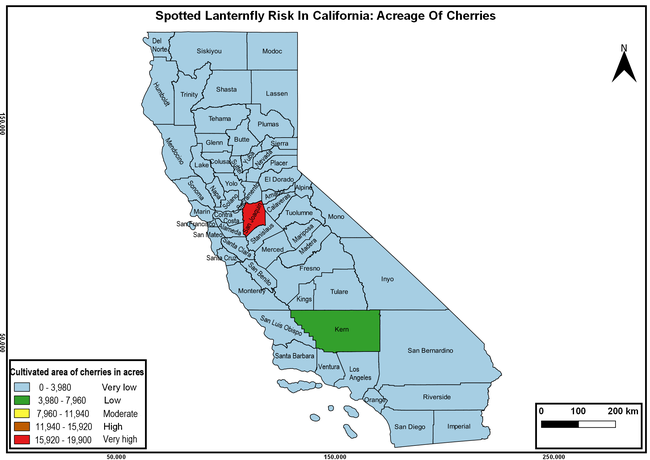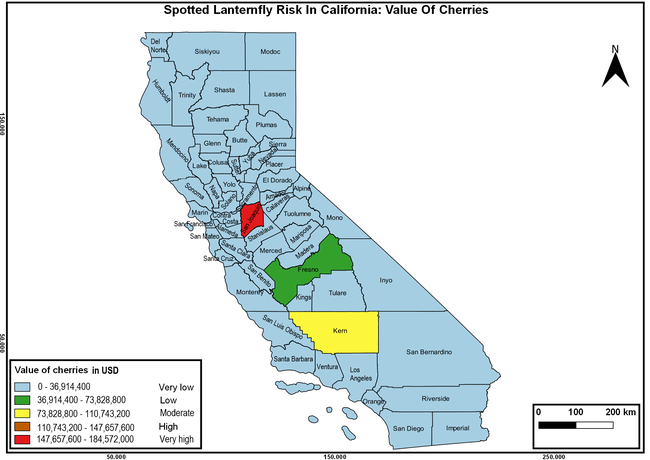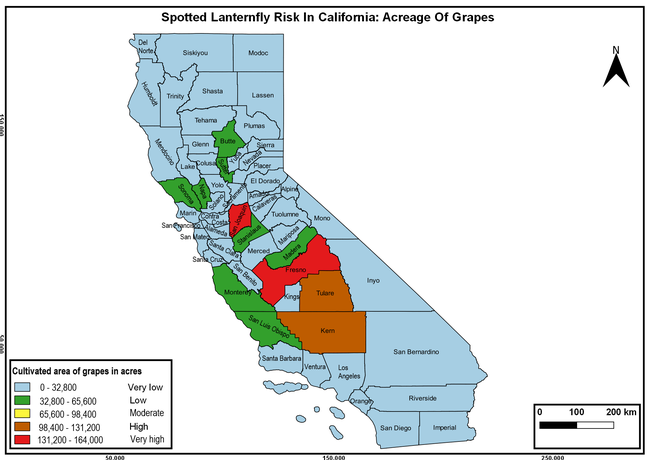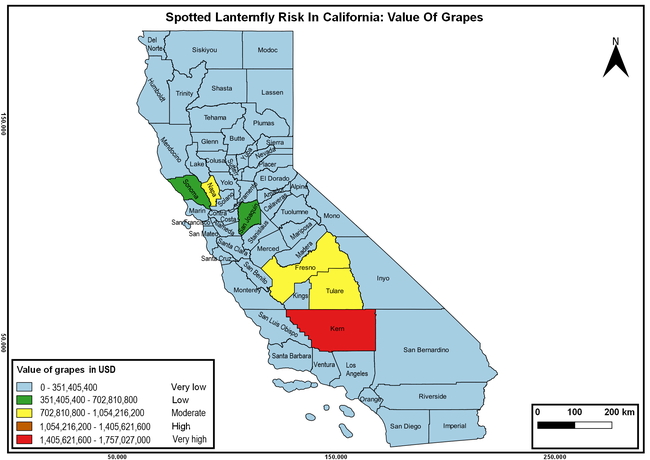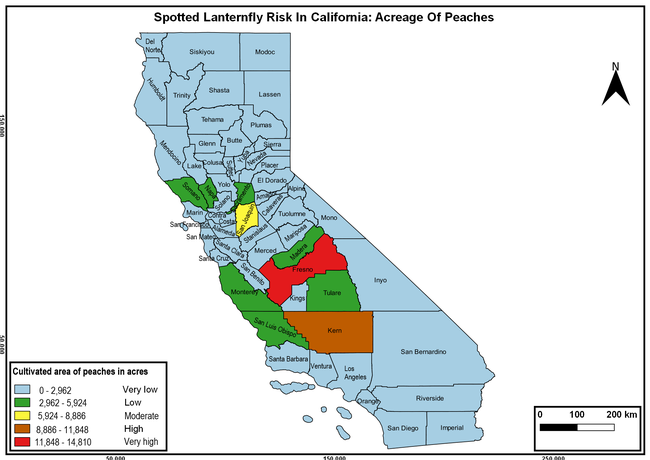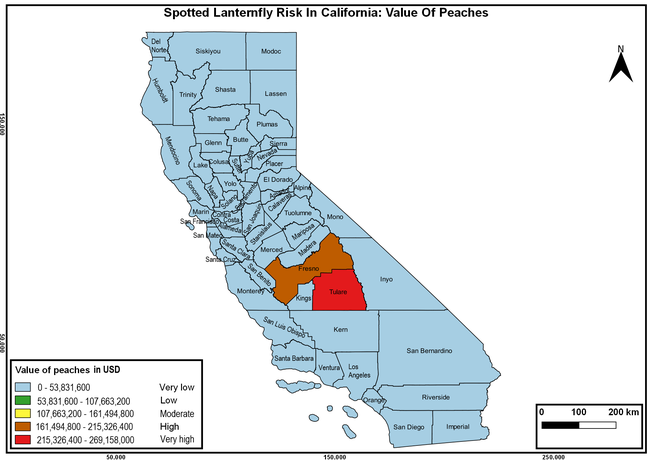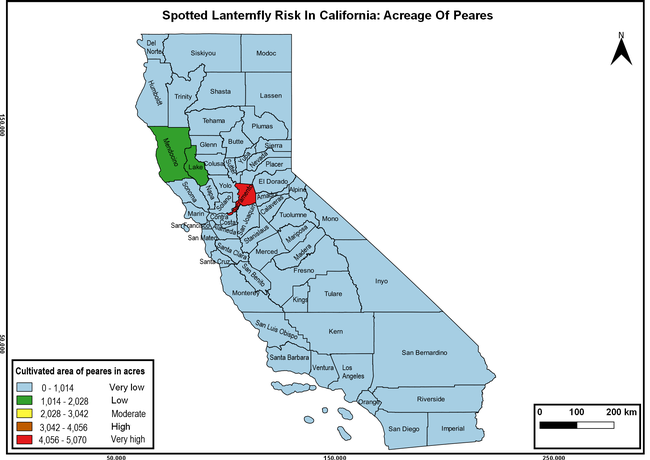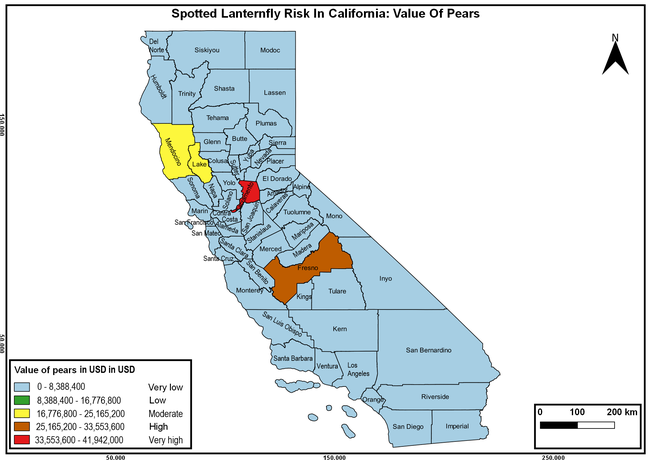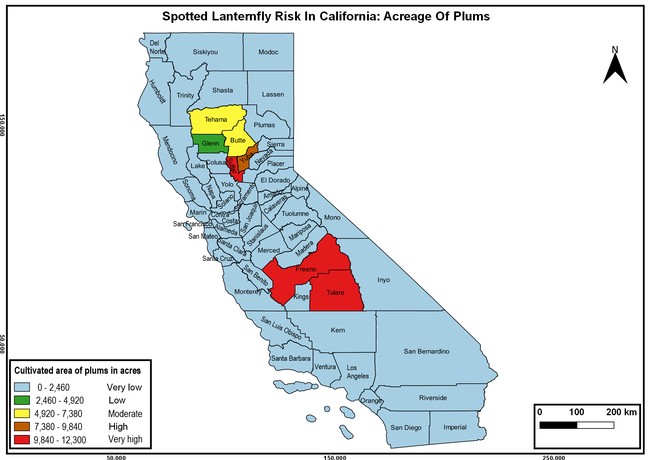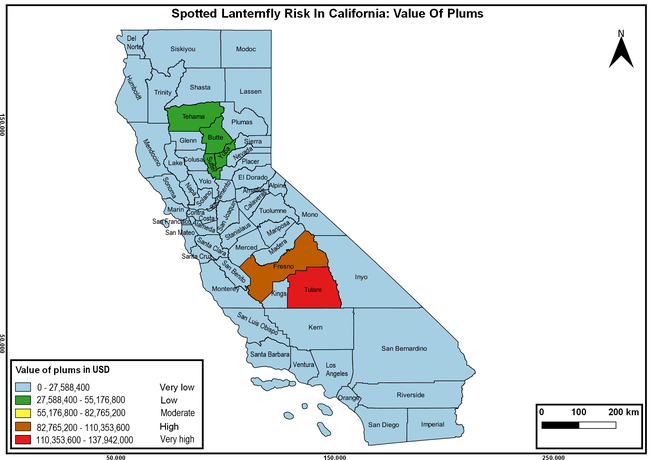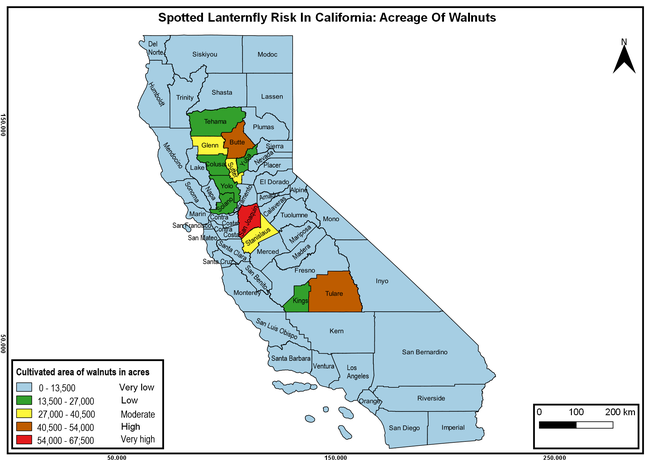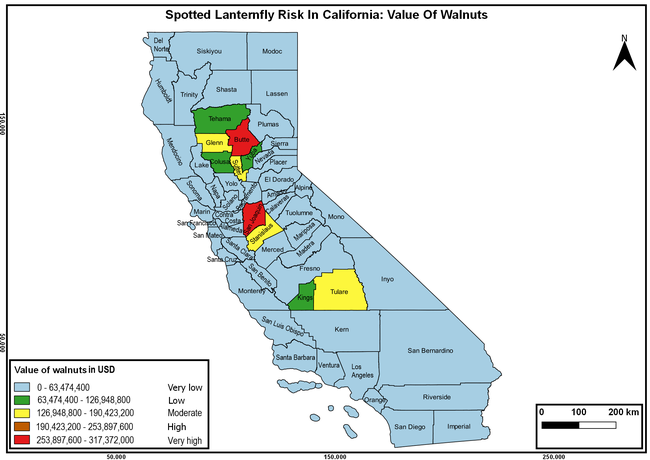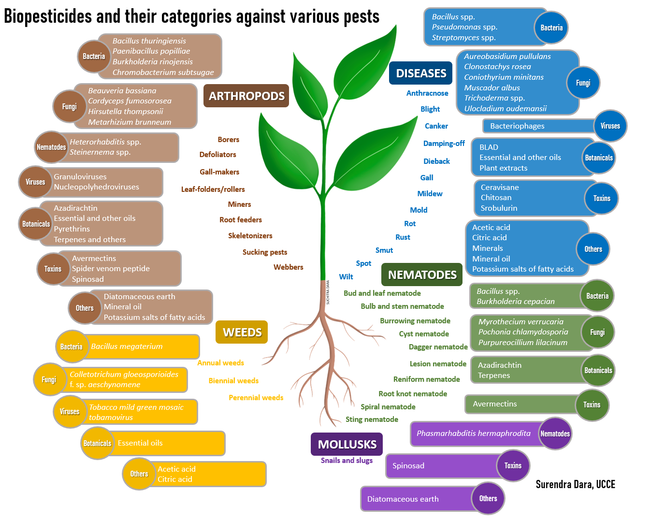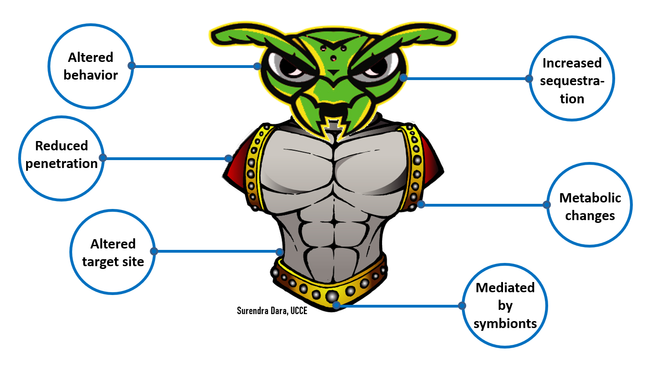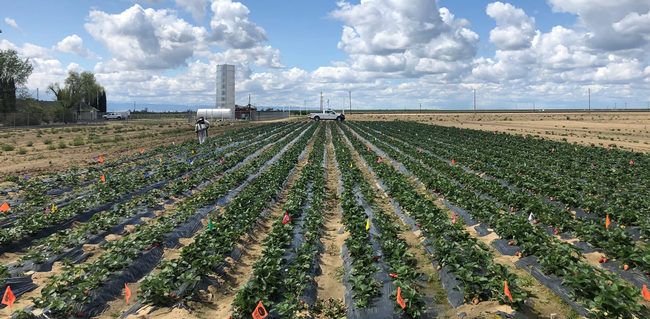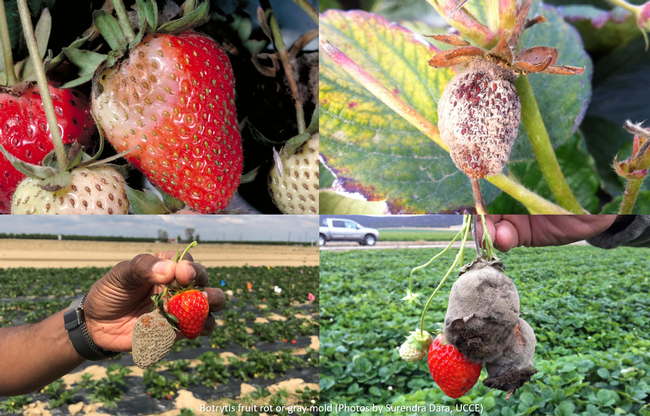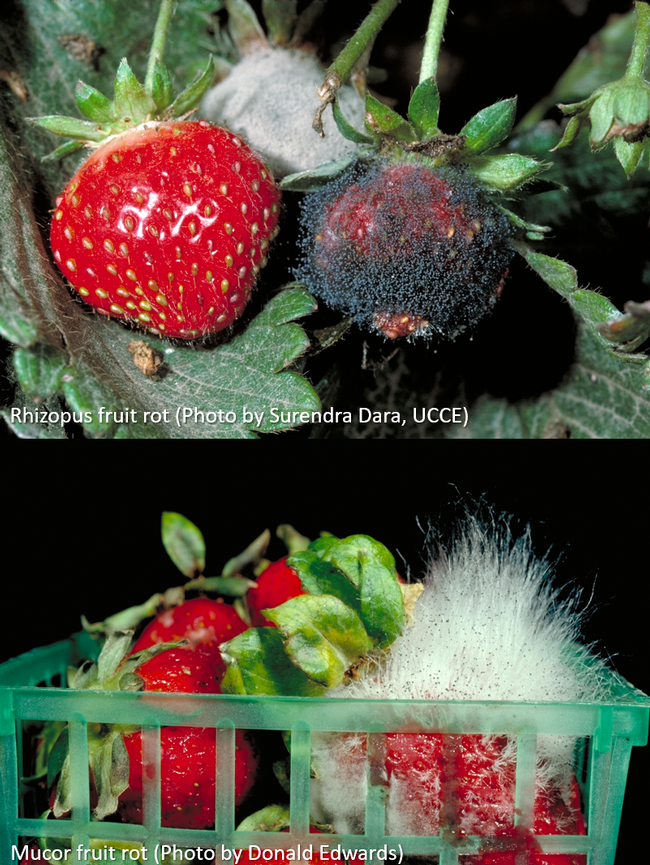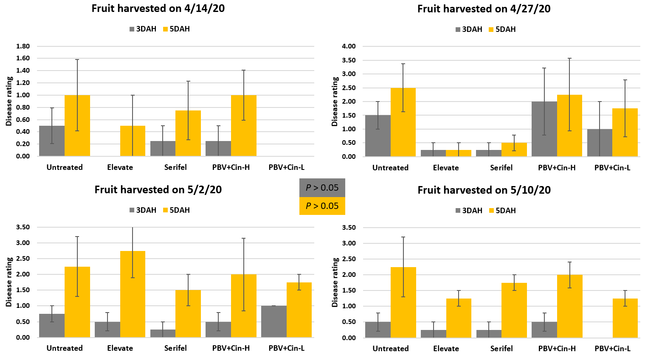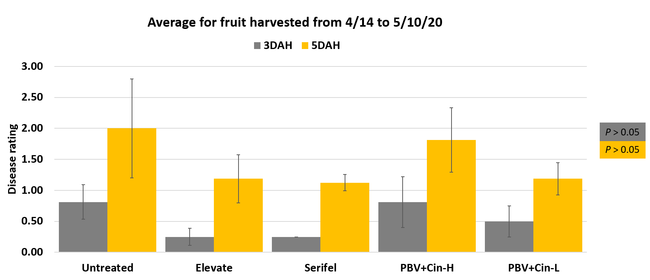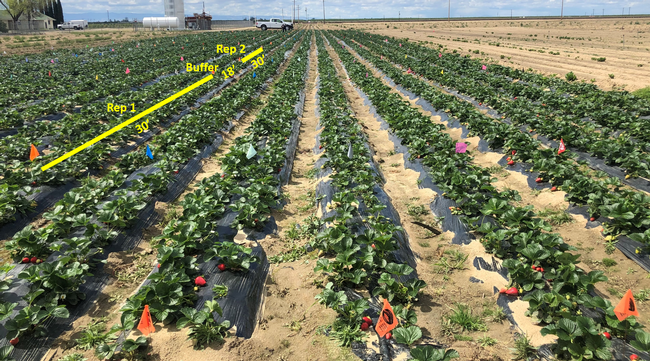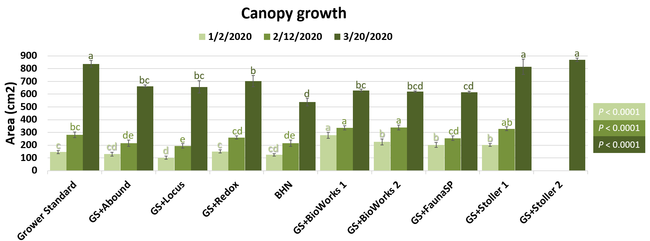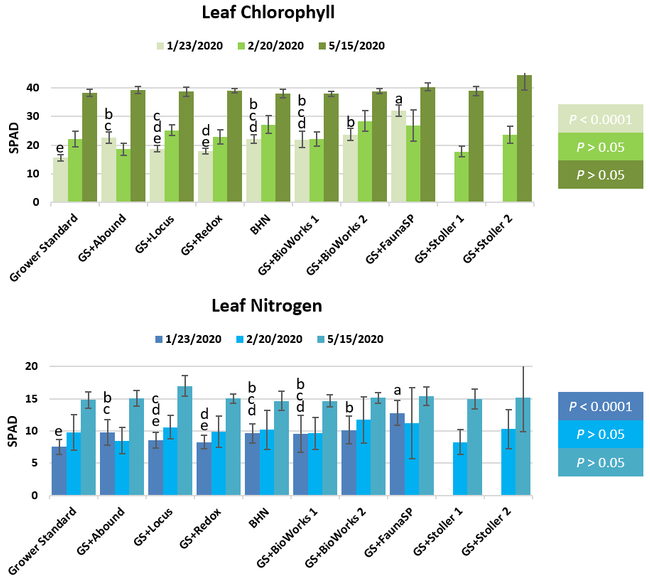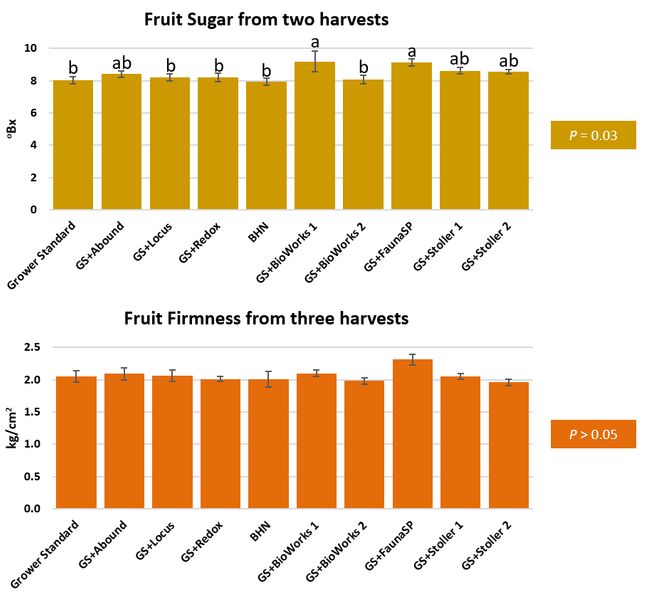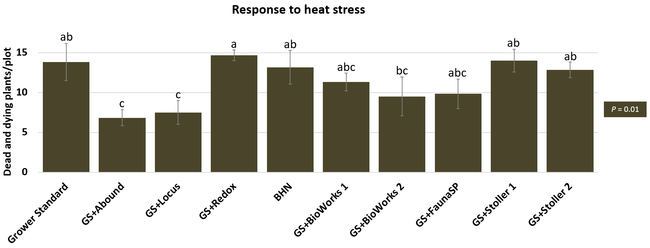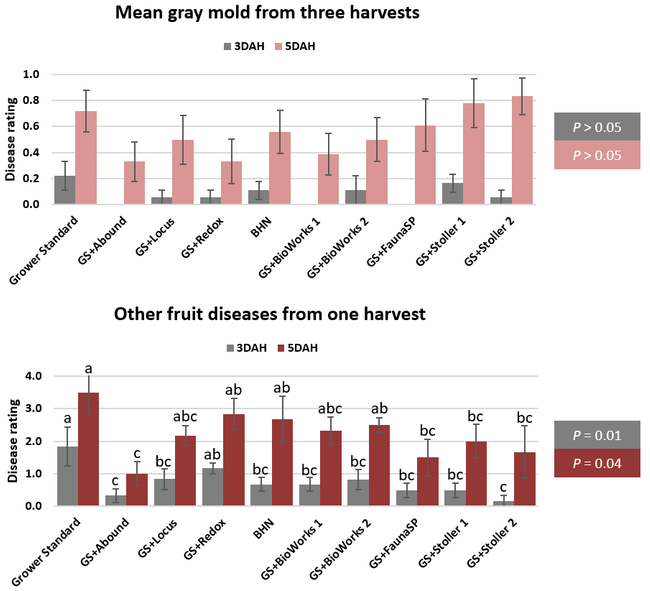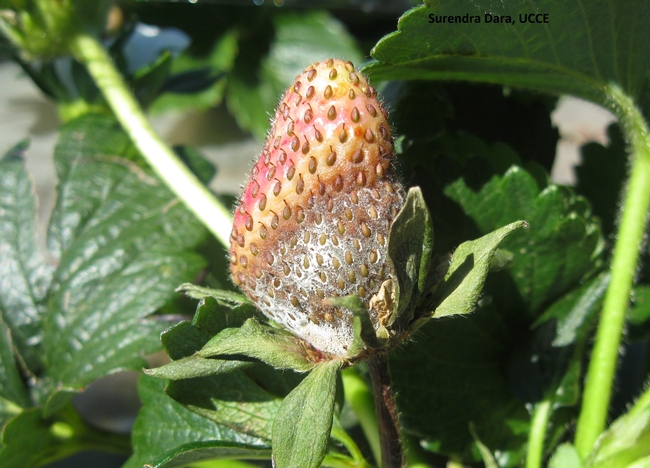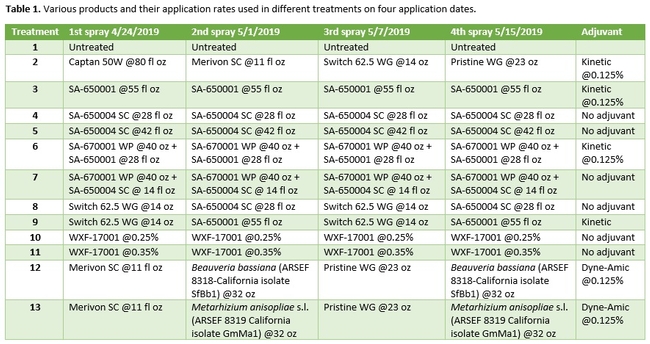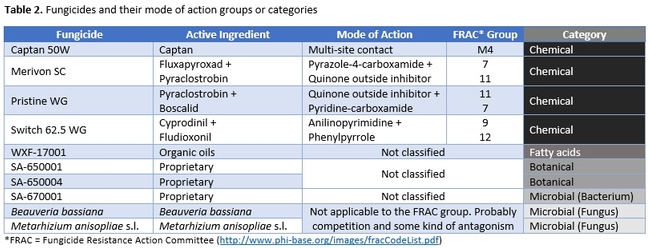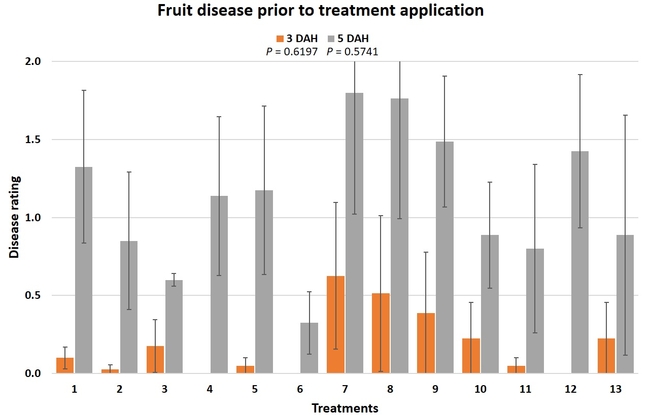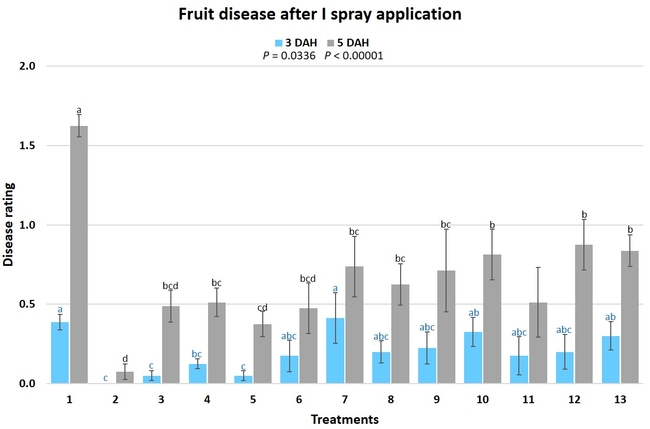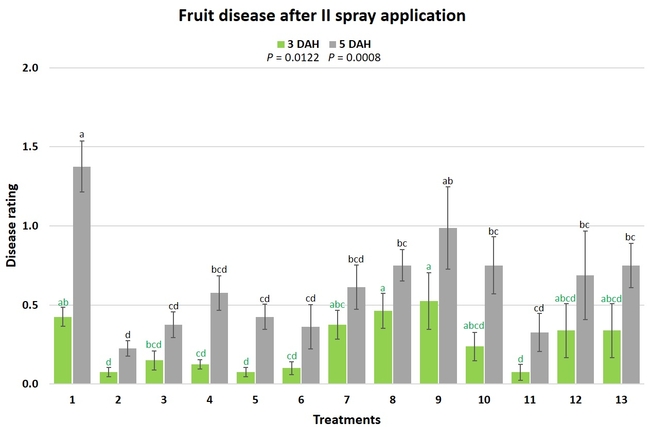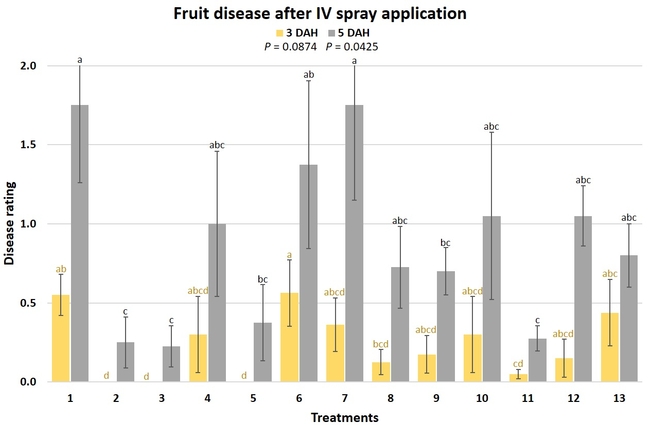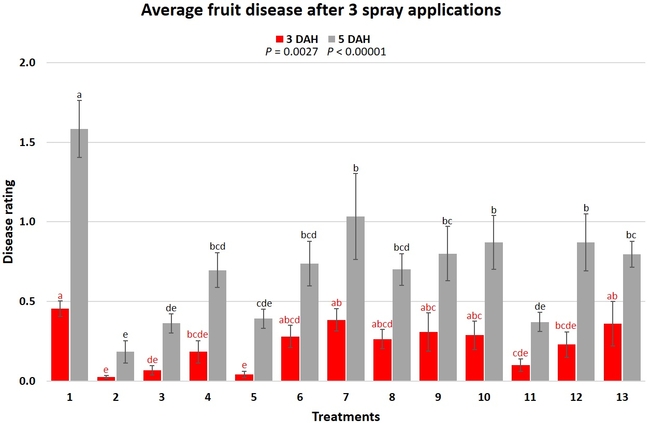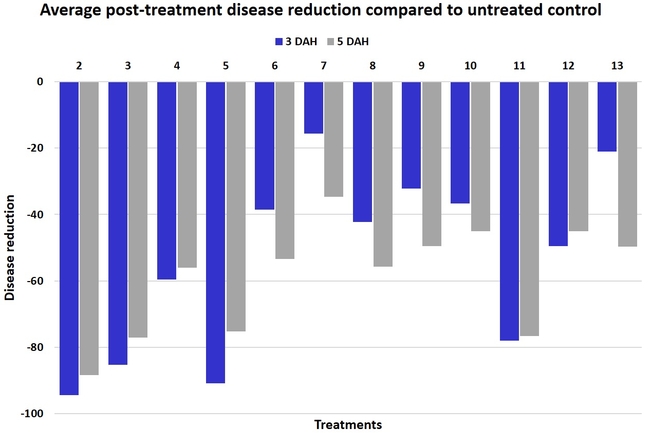- Author: Surendra K. Dara
- Author: Roland C. Bocco
The spotted lanternfly (SLF) [Lycorma delicatula (Hemiptera: Fulgoridae)] is an invasive planthopper, which causes a significant damage to apples, grapes, stone fruit, trees used for timber, and other hosts (Dara et al. 2015). Native to China, SLF was first reported in 2014 in Pennsylvania and has been rapidly spreading in the eastern United States and moving westward. California has 22 cultivated and about 70 wild hosts of SLF and include several high value crops such as apples, cherries, grapes, and plums. The tree-of-heaven, an invasive species, is a favorite host of SLF and is widely distributed in California. SLF is also a nuisance pest with 100s or 1000s of individuals infesting landscape trees and hosts in residential areas. This pest deposits eggs on inanimate objects such as vehicles, furniture, stones, and packages and thus spread to other areas through the movement of these objects. Awareness of the pest and its damage potential, ability of Californians to recognize and report the pest if found, and the knowledge of control practices will help prevent accidental transportation of eggs or other life stages from the infested areas to California and prepare the citizens to take appropriate actions. Outreach efforts have been made in California since 2014 through extension articles, presentations at extension meetings, videos, social media posts, and personal communication (Dara, 2014).
Wakie et al. (2020) modeled the establishment risk of SLF in the United States and around the world and indicated that many coastal regions and the Central Valley of California are among the high-risk areas. Considering the risk to several high-value commodities and the presence of several wild hosts that are distributed all over California, mapping of the risk-prone areas based on the cultivated hosts, their acreage and value in different counties, and the distribution of wild hosts was done to help both growers and other Californians to prepare for potential invasion of SLF.
Methodology
The list of SLF hosts is continuously evolving with host specificity studies in various places. Based on two published resources (Dara et al. 2015; Barringer and Ciafré 2020), 22 cultivated and 70 wild hosts appear to be present in California. Plant species that support some of the feeding life stages or all life stages were included in preparing these lists. The cultivated hosts include apples, apricots, basil, blueberries, butternut, cherries, cotton, grapes, hibiscus, hops, mock orange, nectarine, peaches, pears, persimmon, plums, pomegranates, roses, soybean, sponge gourd, tea, and walnuts; and the wild hosts include Acacia sp., American hazelnut, Amur corktree, American linden, American sycamore, arborvitae, Argentine cedar, Asian white birch, bee balm, big-toothed aspen, black gum, black hawk, black locust, black walnut, Bladder senna, boxelder, chestnut oak, chinaberry tree, Chinese boxwood, Chinese juniper, Chinese parasol tree, Chinese wingnut, devilwoods, dogwood, Eastern white pine, edible fig, false spiraea, fireweed, five-stamen tamarisk, flowering dogwood, Forsythia, Glossy privet, greater burdock, grey alder, hemp, hollyhocks, honeysuckle, hornbeam, Japanese angelica, Japanese boxwood, Japanese maple, Japanese snowball, Japanese zelkova, jujubes, Kobus magnolia, Northern spicebush, Norway maple, lacquer tree, perennial salvia, Persian silk tree, plane tree, Poinsettia, poplars, princess tree, red maple, sapphire dragon tree, sassafras , sawtooth, serviceberry, silver maple, slippery elm, snowbell, staghorn sumac, sugar maple, tree-of-heaven, tulip tree, Virginia creeper, white ash, wild grape, and willows.
The summary of county crop reports from the California Department of Food and Agriculture (CDFA 2018) was used to determine the value and acreages of the cultivated hosts. To determine the distribution of wild hosts various online resources were used. SLF risk levels were determined as very low, low, moderate, high, and very high for the number of hosts, acreage and value of each cultivated host, and other such parameters within each county. The highest risk value within each parameter was used to determine ‘very high' category and 4/5, 3/5, 2/5, and 1/5 were used for high, moderate, low, and very low categories, respectively. In other words, 0-20% risk was considered very low, 21-40% as low, 41-60% as moderate, 61-80% as high, and 81-100% as very high for each measured parameter. Data were entered into a spreadsheet and maps were generated using QGIS open-source cross-platform geographic information system application.
Risk-prone areas in California
The following maps show areas in California that are prone to SLF risk based on the distribution of cultivated and wild hosts, and the acreage and value of important cultivated crops.
Based on these maps, the entire state of California is at some level of risk. In addition to the commercially produced crops, several backyard or landscape plant species such as roses, grapes, peaches, plums, and others are present throughout the state and can harbor SLF. Such host plants in residential and urban landscapes can serve as SLF sources for commercial crops. The tree-of-heaven is present throughout California and several such uncultivated hosts can serve as sources of undetected infestations. While researchers are working on appropriate biocontrol solutions such as releasing natural enemies, other control options such as synthetic and microbial pesticide applications, sticky traps, removal of egg masses and wild hosts, and other strategies can help manage SLF. In the meantime, Californians will benefit by knowing about this pest and its potential risk to the state. The ability to identify, destroy or capture, and report the pest to county and state departments or University of California Cooperative Extension offices will help prevent or delay SLF invasion and spread in California.
Conclusion
California is at the risk of SLF invasion and spread. Depending on the number of cultivated crops, their acreage, value, and the distribution of wild hosts, the risk level varies in various counties throughout the state. Outreach efforts are helping to alert Californians about SLF and its damage to cultivated crops and nuisance in urban and residential areas.
Additional resources
Refer to https://ucanr.edu/spottedlanternfly for additional information about the pest. If you happen to see this pest in California, please contact your local Agricultural Commissioner, California Department of Food and Agriculture, or UC Cooperative Extension office to report.
Acknowledgments
Thanks to the California Department of Food and Agriculture for funding this study.
References
Barringer, L. and Ciafré, C. M. 2020. Worldwide feeding host plants of spotted lanternfly, with significant additions from North America. Environ. Entomol. 49: 999-1011.
CDFA (California Department of Food and Agriculture). 2018. California County Agricultural Commissioners' Report Crop Year 2016-2017 (https://www.cdfa.ca.gov/statistics/pdfs/2017cropyearcactb00.pdf).
Dara, S. K. 2014. Spotted lanternfly (Lycorma delicatula) is a new invasive pest in the United States. UCANR eJournal Pest News (https://ucanr.edu/blogs/blogcore/postdetail.cfm?postnum=15861).
Dara, S. K. 2018. An update on the invasive spotted lanternfly, Lycorma delicatula: current distribution, pest detection efforts, and management strategies. UCANR eJournal Pest News (https://ucanr.edu/blogs/blogcore/postdetail.cfm?postnum=26349).
Dara, S. K., Barringer, L. and Arthurs, S. P. 2015. Lycorma delicatula (Hemiptera: Fulgoridae): a new invasive pest in the United States. J. Integr. Pest Manag. 6: 20.
Wakie, T. T., Nevin, L. G., Yee, W. L. and Lu, Z. 2020. The establishment risk of Lycorma delicatula (Hemiptera: Fulgoridae) in the United States and globally. J. Econ. Entomol. 113: 306-314.
- Author: Surendra K. Dara
Biopesticides contain active ingredients of natural or biological origin that include plant extracts, microorganisms, microbial metabolites, organic molecules, minerals, or other such natural materials that have pesticidal properties. Pests such as herbivorous arthropods, pathogens, parasitic nematodes, mollusks, rodents, and weeds cause significant crop damage when they are not managed. Pest suppression is a critical part of crop production to maintain plant health, prevent yield losses, and optimize returns. As agriculture advanced from subsistence farming to a global enterprise, crop protection also evolved over millennia. When farming was less organized, nature maintained a balance and provided solutions initially. Then natural solutions were actively implemented until industrialization led to the use of synthetic inputs in the 20th century. While synthetic fertilizers and pesticides contributed to a tremendous improvement in the yield potential, the indiscriminate use of some of them and the resulting damage to the environment and human health steered food production in the recent past towards organic farming with the use of nature-based solutions.
Although biopesticides have been around for a few decades, the growth of organic farming gave an impetus to the biopesticide industry during the past few years resulting in the development of new active ingredients and improved formulations. Now, biopesticides are considered an important part of integrated pest management (IPM) strategies in both organic and conventional systems. With a considerable industry investment in research and development, the quality and efficacy of biopesticides have also significantly improved. This has also contributed to optimizing the cost of some formulations. However, there is still a need to fill the knowledge gaps in biopesticides and their use. Depending on the active ingredient, the mode of action for biopesticides, their target pests, their storage and handling, and the use strategies are quite diverse, and a thorough understanding of these aspects is critical for their successful use. As emphasized in the new IPM model (Dara, 2019), while biopesticide use is an integral part of crop protection, understanding the pest biology, using biopesticides appropriate for the target life stage of the pest, applying them at the right time and rate using the right technology, avoiding incompatibility issues, building and sharing effective use strategies, and continuously investing in research and outreach are essential elements of biopesticide use. Biopesticides also play an important role in insecticide resistance management (IRM) to address resistance issues associated with synthetic pesticides. This article provides an overview of various biopesticide categories and general strategies for their successful use for IPM and IRM.
Biopesticides can be used for managing arthropod pests, bacterial or fungal pathogens, plant-parasitic nematodes, weeds, and snails and slugs. Some formulations or active ingredients have multiple roles and can be effective against more than one category of pests. While some active ingredients are very specific to a particular pest or related species, others have a broad-spectrum activity. Based on the source, biopesticides can be placed in four broad categories: i) botanicals, ii) microbials, iii) toxins, and iv) minerals and other natural materials.
Botanical extracts: Plants are a rich source of numerous phytochemicals or secondary metabolites that have a wide range of properties including pesticidal activity. Acids, alkaloids, flavonoids, glycosides, saponins, and terpenoids in plant extracts or oils obtained from seeds and other plant parts are some of the compounds present in various biopesticides (Pino et al., 2013). Azadirachtin, BLAD (polypeptide from sweet lupine seeds), citric acid, essential oils, pyrethrins, soybean oil, and extract of the giant knotweed are used for their acaricidal, insecticidal, fungicidal, nematicidal, or herbicidal properties.
Microbials: Some of the microbial pesticides have live microorganisms (such as entomopathogens, Bacillus spp., Streptomyces spp., and Trichoderma spp.) while others (such as Burkholderia rinojensis and Chromobacterium subtsugae)have heat-killed microorganisms and fermentation solids as the active ingredients. Entomopathogenic microorganisms [Bacillus thuringiensis (bacterium), Beauveria bassiana and Cordyceps fumosorosea (fungi), Heterorhabditis spp. and Steinernema spp. (nematodes), and granuloviruses and nucleopolyhedroviruses] primarily kill their hosts through infection; microbe-based fungicides antagonize plant pathogens through competitive displacement and production of toxic metabolites; nematophagous fungi parasitize plant-parasitic nematodes; and plant pathogenic bacteria, fungi, and viruses infect and suppress weeds. Bacteriophages, which are viruses that parasitize bacteria, are used against the plant pathogenic species of Clavibacter, Erwinia, Pseudomonas, Xanthomonas, Xylella, and other genera.
Toxins and other organic molecules: There are multiple examples of toxic organic molecules derived from various organisms. Avermectins from the bacterium Streptomyces avermitilis and spinosad from the bacterium Saccharopolyspora spinosa, strobilurin from the mushroom Strobuluris tenacellus, and cerevisane from the yeast Saccharomyces cerevisae are some of the microbial toxins that are effective against insects, plant-parasitic nematodes, or snails and slugs. A venom peptide from the Blue Mountains funnel-web spider, Hadronyche versuta, from Australia is a recently developed insecticide active ingredient with its unique mode of action class. Chitosan, a polysaccharide from the exoskeleton of shellfish, is a fungicide.
Minerals and other natural materials: Diatomaceous earth, mineral oil, and minerals such as sulfur are used for controlling multiple categories of pests. Potassium salts of fatty acids of plant or animal origin, known as insecticidal soap, have insecticidal and fungicidal properties. Organic acids such as acetic acid and citric acid are derived from plants and have fungicidal and herbicidal properties. Since these are different from other botanical extracts, they are placed in this category.
Except for the microbial pesticides that have live microorganisms, most biopesticides have chemical molecules of microbial, fungal, botanical, or mineral origin and work through various modes of action similar to synthetic pesticides. Several synthetic pesticides are developed from natural molecules. Abamectin, pyrethroids, neonicotinoids, spinetoram, and storbulurins are synthetic analogs based on avermectins, pyrethrins, nicotine, spinosad, and strobulurin, respectively, and were developed for improved stability, safety, or ease of commercial-scale production.
Integrated pest management and resistance management: Biopesticides are very diverse in their origin and mode of action and have been successfully used in several cropping systems for managing a variety of pests. They have complex interactions with plants, soil microbiota, pests, and environmental conditions. It is critical to have a good understanding of the source of biopesticides and how they act on their target pests. Certain biopesticides may have special storage and handling requirements or tank-mixing restrictions. It is essential to refer to the manufacturer's guidelines or label instructions to avoid incompatible tank-mix combinations, understand proper application sequences, and to store, transport, and apply under unfavorable conditions. While it is very important to use biopesticides as a part of the IPM program and tools for IRM, caution is warranted to avoid repeated use of the same or a similar type of biopesticide. Pests can develop resistance to biopesticides just as they do to synthetic pesticides (Dara, 2020).
Strategies for using biopesticides: From the seed or transplant treatment to soil or foliar application, biopesticides can be used throughout crop production. Certain combinations can have an additive or a synergistic effect on pest suppression. At the same time, certain inputs or practices can negatively impact biopesticide efficacy. For example, alkaline tank-mix components breakdown the protein coat of entomopathogenic viruses and Bacillus thuringiensis. Botanical oils can be incompatible with cold water. Some fungicides such as captan and thiram are incompatible with entomopathogenic fungi like Beauveria bassiana while several others are compatible (Dara et al., 2014).
Investing in biopesticides: Environmental safety and resistance development are two major concerns for excessive use of synthetic pesticides and incorporating biopesticides into IPM will help address both issues. Substituting biopesticides for synthetic pesticides will reduce the total amount of the latter during a production season and their potential negative impact on the environment and human health. Several biopesticides are not harmful to pollinators and in some production systems, pollinators are used to deliver biopesticides to the crops they pollinate. Adding biopesticides to the standard crop protection program will also increase pest control efficacy. Additionally, by not continuously using synthetic pesticides, the risk of resistance will be reduced and thus their efficacy will continue to be maintained. Although some biopesticides can be more expensive than synthetic pesticides, investing in them will be a good strategy for both the short-term benefit of effective pest suppression and the long-term benefit of a healthy and resilient ecosystem. Since pests do not have boundaries, area-wide implementation of good agricultural practices with a balanced use of synthetic and natural inputs is necessary for maintaining the productivity of the cropping systems.
Productive collaborations among the pesticide industry, researchers, extension educators, and the grower community are critical for successfully using biopesticides for sustainable food production. While research helps to develop effective formulations and their use strategies, outreach helps with the implementation of those strategies.
References
Dara, S.S.R., S. S. Dara, A. Sahoo, H. Bellam, and S. K. Dara. 2014. Can entomopathogenic fungus Beauveria bassiana be used for pest management when fungicides are used for disease management? UCANR eJournal of Entomology and Biologicals. https://ucanr.edu/blogs/blogcore/postdetail.cfm?postnum=15671
Dara, S. K. 2019. The new integrated pest management paradigm for the modern age. J. Integr. Pest Manag. 10 (1): 12. https://doi.org/10.1093/jipm/pmz010
Dara, S. K. 2020. Arthropod resistance to biopesticides. Organic Farmer 3 (4): 16-19. https://organicfarmermag.com/2020/08/arthropod-resistance-to-biopesticides/
Pino, O. Y. Sánchez, and M. M. Rojas. 2013. Plant secondary metabolites as an alternative in pest management. I: Background, research approaches and trends. Rev. ProtecciónVeg. 28 (2): 81-94.
- Author: Surendra K. Dara
Several crown, fruit, and foliar diseases cause significant yield losses to strawberry. Gray mold or Botrytis fruit rot caused by Botrytis cinerea, mucor fruit rot by Mucor spp., and Rhizopus fruit rot by Rhizopus spp. are common fungal diseases in California. Botrytis cinerea is more prevalent and damaging fungus among these pathogens warranting regular fungicidal applications. Fungal spores survive in plant debris and soil and infection can occur before flower initiation. Both flowers and fruits are subjected to infection. Severely infected flowers fail to develop into fruits. Infection on developing or ripe fruit occurs as brown lesions, usually under calyxes. Infected areas rot and become dry and leathery under dry conditions or produce a thick, gray mat of spores under cool, moist conditions.
Mucor spp. invade the fruit through ruptured skin and cause leaky fruit rot. Under high humidity, profuse fungal growth of white, tough filaments with black spore-bearing structures is seen covering the fruit. In the case of Rhizopus fruit rot, discolored, water-soaked spots develop on fruit eventually leading to wilting. Similar to the Mucor fruit rot, Rhizopus rot also leads to leaky fruits and development of black spore-bearing structures on white mycelia under high humidity. Both pathogens survive in dead and decaying plant material and can persist in the field.
In a fall-planted conventional strawberry, growers usually make 12 or more fungicidal applications during a four-month period to control Botrytis and other fruit rots. Although fungicides with different modes of action are present and growers try to rotate them, fungicide resistance in B. cinerea is common and effective integrated disease strategies are necessary. Using biostimulants that might improve plant's ability to withstand diseases and alternating chemicals with biological fungicides could be some options to mitigate chemical fungicide resistance. Previous studies looked at the response of fruit diseases to various treatments that received biological soil amendments (Dara, 2020a), soil fungicides (Dara, 2020b), or chemical and biological fungicides (Dara, 2019). This study was conducted to evaluate the efficacy of some biological fungicides along with a chemical fungicide primarily against Botrytis fruit rot.
Methodology
This study was conducted at a research strawberry field at the Shafter Research Station. Strawberry cultivar San Andreas was planted on 31 October 2019. Other than regular irrigation and fertigation, plants in this study were not treated with any agricultural inputs for agronomic or pest management purposes. Treatments included i) untreated control, ii) Elevate 50 WDG (fenhexamid) at 8 oz/ac, iii) Serifel (Bacillus amyloliquefaciens) at 8 oz/ac, iv) ProBlad Verde (Banda de Lupinus albus doce – BLAD, a polypeptide from sweet lupine) at 36 fl oz with Cinnerate (cinnamon oil) at 0.25% followed by ProBlad Verde at 36, 43, and 43 fl oz/ac on subsequent applications, and v) ProBlad Verde at 36 fl oz with Cinnerate at 0.25% followed by three subsequent applications of ProBlad Verde at 32 fl oz/ac. Each treatment had a 3.2' wide and 14' long plot with two rows of plants and replicated four times in a randomized complete block design. Treatments were applied using a CO2-pressurized backpack sprayer using a 45 gpa spray volume on 26 March, 2, 10, and 20 April 2020. Flowers and fruits were removed from all the plants before the first application. Fruit was harvested on 14 and 27 April and 2 and 10 May and stored in vented plastic containers for postharvest quality assessment. The severity of Botrytis and other fruit rots was recorded 3 and 5 days after harvest on a scale of 0 to 4 where 0=no disease, 1=1-25% fruit with fungal infection, 2=26-50% infection, 3=51-75%, and 4=76-100%. Compared to Botrytis fruit rot, other rots occurred as mixed infections at different times and it was not possible to accurately measure them separately. Data presented in this study primarily represent Botrytis fruit rot with other fruit rots included on some data sets. Data were subjected to analysis of variance using Statistix software to compare disease severity for individual harvest dates and their average.
Results
Fruit rots occurred from low to moderate levels during the observation period. Disease severity followed the usual trend with higher levels 5 days after harvest compared to 3 days after harvest. Compared to untreated control, disease severity was numerically lower in some treatments especially 3 days after harvest, but differences were not statistically significant (P > 0.05) when individual harvest dates or their average were considered. The average disease severity from four harvests was 0.25 in Elevate and Serifel, 0.50 in ProBlad Verde low rate with Cinnerate, and 0.81 in ProBlad Verde high rate with Cinnerate treatment and untreated control 3 days after harvest. The average disease severity was 1.13 for Serifel, 1.19 for Elevate and the low rate of ProBlad Verde with Cinnerate, 1.81 for the high rate of ProBlad Verde with Cinnerate, and 2.0 for untreated control 5 days after harvest. Although statistically significant differences could not be found among treatments, this study indicates the potential of non-chemical alternatives and warrants additional studies for further investigation.
Acknowledgements: Thanks to BASF and Sym-Agro for funding this study and Marjan Heidarian Dehkordi and Zach Woolpert for the technical assistance.
References
Dara, S. K. 2019. Five shades of gray mold control in strawberry: evaluating chemical, organic oil, botanical, bacterial, and fungal active ingredients. UCANR eJournal of Entomology and Biologicals. https://ucanr.edu/blogs/blogcore/postdetail.cfm?postnum=30729
Dara, S. K. 2020a. Improving strawberry yields with biostimulants and nutrient supplements: a 2019-2020 study. UCANR eJournal of Entomology and Biologicals. https://ucanr.edu/blogs/blogcore/postdetail.cfm?postnum=43631
Dara, S. K. 2020b. Impact of drip application of fungicides on strawberry health and yields. UCANR eJournal of Entomology and Biologicals. https://ucanr.edu/blogs/blogcore/postdetail.cfm?postnum=43632
- Author: Surendra K. Dara
Balanced nutrient inputs are essential for optimal plant growth and yields. Depending on the soil, crop, and environmental conditions, certain nutritional supplements further enhance crop performance. While macro- and micro-nutrients are necessary for plant growth and optimal yields, biostimulants play multiple roles by increasing the bioavailability of nutrients, improving nutrient and water absorption, protecting plants from pestiferous organisms either through direct antagonism or by triggering plants defense mechanisms (Berg, 2009; Dara, 2019a). In addition to improving health and yields, biostimulants are also known to increase nutritional quality (Parađiković et al., 2011; Fierentino et al., 2018). Multiple field studies in California demonstrated the potential of biostimulants and soil amendments in improving yields in tomato (Dara, 2019b; Dara and Lewis, 2019) and strawberry (Dara and Peck, 2018; Dara, 2019a). As the knowledge of biostimulants and their potential for sustainable agriculture is expanding, there has been a steady introduction of biostimulant products in the market warranting additional studies. A study was conducted to evaluate the potential of different biostimulant materials on strawberry growth, health, and fruit yields.
Methodology
This study was conducted in an experimental strawberry field at the Shafter Research Station during 2019-2020. Cultivar San Andreas was planted on 29 October 2019. No pre-plant fertilizer application was made in this non-fumigated field which had both Fusarium oxysporum and Macrophomina phaseolina infections in previous year's strawberry planting. Each treatment was applied to a 300' long bed with single drip tape in the center and two rows of strawberry plants. Sprinkler irrigation was provided immediately after planting along with drip irrigation, which was provided one or more times weekly as needed for the rest of the experimental period. Each bed was divided into six 30' long plots, representing replications, with an 18' buffer in between. This study included both biostimulant and nutrient supplements, but this article presents data from the biostimulant treatments only. Treatments were applied either as fertigation through the drip system using a Dosatron or sprayed over the plants with a handheld garden sprayer. The following treatments were evaluated in this study:
i) Grower Standard (GS): Between 6 November 2019 and 9 May 2020, 1.88 qt of 20-10-0 (a combination of 32-0-0 urea ammonium nitrate and 10-34-0 ammonium phosphate) and 1.32 qt of potassium thiosulfate was applied 20 times at weekly intervals through fertigation. This fertilizer program was used as the standard for all treatments except for the addition of biostimulant materials.
ii) GS + Abound: Transplants were dipped in 7 fl oz of Abound (azoxystrobin) fungicide in 100 gal of water for 4 min immediately prior to planting. Transplant dip in a fungicide is practiced by several growers to protect from fungal diseases and is considered as another standard in this study.
iii) GS + Locus program: Applied Str10 (Wickerhamomyces sp.) at 5 fl oz/ac with molasses at 10 fl oz/ac immediately after planting and Rhizolizer (Trichoderma harzianum and Bacillus amyloliquefaciens) at 3 fl oz with a food source blend at 10 fl oz 2 weeks after Str10 application through the drip system. Repeated the same pattern starting from mid-February 2020. From February to May, applied 6 fl oz/ac of Rhizolizer with 20 fl oz/ac of food source once a month. Str10 is an unregistered product with yeast that is expected to help with nutrient uptake and phosphorous mobilization for improved plant vigor and yield. Rhizolizer is expected to solubilize soil nutrients and improve crop growth and yield.
iv) GS + Redox program: Starting from about one month after planting, diKaP (0-31-50 NPK) was applied as a foliar spray at 2 lb in 50 gpa every two weeks. In addition to potassium and phosphorus, diKaP also contains proprietary soluable carbon compounds that improve antioxidant production leading to increased plant respiration and tolerance to abiotic stress.
v) Bio Huma Netics (BHN) program: Transplants were dipped in 10 gal of water with 6.4 fl oz of BreakOut (4-14-2 NPK), 1.28 fl oz of Promax (thyme oil), 1.28 fl oz of Vitol (8-16-4 NPK with iron, manganese, sulfur, and zinc), and 1.28 fl oz of Zap (8-0-0 N with iron, manganese, sulfur and zinc) for 4 min immediately prior to planting. Custom blends of macro- and micro-nutrients (Ultra Precision A and B) were prepared based on soil (pre-planting) and plant tissue analyses and applied as a substitute to the grower standard fertility program. Ultra Precision A during the first 30 days after planting and Ultra Precision B for the rest of the study period were applied at weekly intervals at 1.6 gal/bed for a total of 12 times (compared to 20 fertigation events for the grower standard program). Ultra Precision blends were made with Super Phos/Phos-Max, Super Potassium, X-Tend, Nitric acid, Calcium, 44 Mag, BreakOut, Vitol, Max Pak, Iro-Max, Activol, Comol, and Surf-Max that provided N, P, and K along with boron, calcium, cobalt, copper, iron, magnesium, manganese, molybdenum, and sulfur.
vi) GS + BioWorks program 1: Applied 32 fl oz of ON-Gard (based on soy protein hydrolysate) every two weeks through the drip system from planting until canopy develops and then applied as a foliar spray in 50 gpa. ON-Gard is expected to increase the nutrient use efficiency and decrease abiotic stress to the plants.
vii) GS + BioWorks program 2: Applied 32 fl oz of ON-Gard (soy protein-based) every two weeks through the drip system from planting until canopy develops and then sprayed in 50 gpa. Also applied RootShield Plus WP (T. harzianum and T. virens) at 2 lb/ac through drip immediately after planting and 1 lb/ac at the end of November and again at the end of December 2019. RootShield is a biofungicide expected to protect strawberry from phytopathogens and improve water and nutrient uptake.
viii) GS + Fauna Soil Production (FSP) program: Applied CropSignal at 10 gpa six days prior to planting and at 5 gpa 30 after transplanting through the drip system. CropSignal is a carbon-based nutrient formula containing botanical extracts and along with cobalt, copper, manganese, and zinc and is expected to support the growth and diversity of beneficial aerobic soil microbes for improved soil structure, water retention, nutrient cycling, and plant protection.
ix) GS + Stoller program 1: Applied Stoller Root Feed Dry (9-0-5 NPK with boron, calcium, magnesium, and molybdenum) at 10 lb/ac every 10 days starting from 19 February 2020 and Stoller Grow (4-0-3 NPK with copper, magnesium, manganese, and zinc) at 8 fl oz/ac once on 27 February 2020 through the drip system. Stoller Root Feed Dry is expected to promote continuous root growth by maintaining nutritional balance while Stoller Grow is expected to increase growth efficiency and abiotic stress tolerance.
x) GS + Stoller program 2: Applied Harvest More Urea Mate (5-10-27 NPK with boron, calcium, cobalt, copper, magnesium, manganese, molybdenum, and zinc) at 10 lb/ac along with Stoller Crop Mix (algal extract with boron and calcium) at 8 fl oz/ac every 10 days starting from 19 February 2020 and Stoller Grow at 8 fl oz/ac once on 27 February 2020 through the drip system. Harvest More Urea Mate is expected to provide optimal plant growth while Stoller Crop Mix is expected to maintain the nutritional balance and improve crop vigor and yields.
Parameters observed during the study included canopy growth (area of the canopy) in January, February, and March; first flower and fruit count in January; leaf chlorophyll and leaf nitrogen (with chlorophyll meter) in January, February, and May; fruit sugar (with refractometer) in March and May; fruit firmness (with penetrometer) in March, April, and May; severity of gray mold (caused by Botrytis cinereae) and other fruit diseases (mucor fruit rot caused by Mucor spp. and Rhizopus fruit rot caused by Rhizopus spp.) 3 and 5 days after harvest (on a scale of 0 to 4 where 0=no infection; 1=1-25%, 2=26-50%, 3=51-75% and 4=76-100% fungal growth) in March and May; sensitivity to heat stress (expressed as the number of dead and dying plants) in May; and fruit yield per plant from 11 weekly harvests between 11 March and 14 May 2020. Data were analyzed using analysis of variance in Statistix software and significant means were separated using the Least Significant Difference test.
Results and Discussion
The impact of treatments varied on various measured parameters. The interactions among plants, available nutrients, beneficial and pathogenic microorganisms in the crop environment, the influence of environmental factors, and how all these biotic and abiotic factors ultimately impact the crop health and yields are very complex. The scope of this study was only to measure the impact of biostimulants and nutrient supplements on growth, health, and yield parameters and not to investigate those complex interactions.
The canopy size does not always correspond with yields but could be indicative of stresses and how the plant is responding to them in the presence of treatment materials. Plants in some treatments had significantly larger canopy size in January and February, but plants in the grower standard and both Stoller programs were significantly larger than the rest by March. Leaf chlorophyll and nitrogen contents were significantly different among treatments only in January where the grower standard plants had the lowest and the plants that received CropSignal had the highest. When the counts of the first onset of flowers and developing fruits were taken in January, plants that received the BioWorks program that only received ON-Gard had the highest number followed by the CropSignal and Abound treatments. Stoller treatments were not included in the study at this time, so data for leaf chlorophyll, nitrogen, and first flower and fruit counts were not available in January. Average fruit sugar was the highest in BioWorks program with ON-Gard alone followed by FSP's Crop Signal, both Stoller programs, and the Abound treatments. There was no statistically significant difference in the average fruit firmness among the treatments. Severity of the gray mold, which occurred at low levels during the observation period, also did not statistically differ among the treatments. However, the severity of other diseases was significantly different among various treatments with the highest level in fruits from the grower standard. Temperatures were unusually high during the last week of May and several plants exhibited heat stress and started to die. The number of dead or dying plants on 28 May was the lowest in Locus and Abound treatments.
There were significant differences in marketable and unmarketable fruit yields among treatments. Highest marketable yields were seen in both Stoller treatments followed by BioWorks program with ON-Gard alone, BHN, and other treatments. Transplant dip in a fungicide seems to have a negative impact on fruit yields as observed in the current study or earlier studies (Dara and Peck, 2017 and 2018; Peck unpublished data). While the grower standard had the highest amount of unmarketable fruits, the Locus treatment had the lowest in this study. Fruit yield and some of the observed parameters appeared to be better in the grower standard compared to some treatments, which has also been seen in some earlier strawberry studies. While biostimulants can help plants under some stresses, providing sufficient macro- and micro-nutrients seems to be critical for higher fruit yields as seen with Stoller and BHN treatments. It is important to note that BHN materials were applied only 12 times compared to 20 applications of the grower standard treatment or other treatments that were applied on top of the grower standard treatment. It is also important to note that when ON-Gard was used alone, it also improved the marketable fruit yields by nearly 12% compared to the grower standard. When marketable fruit yield in the Abound treatment was considered, all treatments performed better 7-50% higher yields. Sometimes natural balance of the nutrients, organic matter, and microbial community in the soil might result in optimal yields in the absence of pathogens or other stressors. However, it is very common to use fungicidal treatments or add biological or supplemental nutrition to protect from potential threats and improving yields. These results help understand the impact of various biostimulants and supplements and warrant the need to continue such studies under various environmental, crop, and soil conditions.
Acknowledgments: Thanks to Bio Huma Netics, BioWorks, Inc., Fauna Soil Production, Locus Agricultural Solutions, Redox Ag, and Stoller for the financial support of the study and Marjan Heidarian Dehkordi and Tamas Zold for their technical assistance.
References
Berg, G. 2009. Plant-microbe interactions promoting plant growth and health: perspectives for controlled use of microorganisms in agriculture. Appl. Microbiol. Biotechnol. 84: 11-18.
Dara, S. K. 2019a. Improving strawberry yields with biostimulants: a 2018-2019 study. UCANR eJournal of Entomology and Biologicals. https://ucanr.edu/blogs/blogcore/postdetail.cfm?postnum=31096
Dara, S. K. 2019b. Effect of microbial and botanical biostimulants with nutrients on tomato yield. CAPCA Adviser, 22(5): 40-45.
Dara, S. K. and D. Peck. 2017. Evaluating beneficial microbe-based products for their impact on strawberry plant growth, health, and fruit yield. UCANR eJournal of Entomology and Biologicals. https://ucanr.edu/blogs/blogcore/postdetail.cfm?postnum=25122
Dara, S. K. and D. Peck. 2018. Evaluation of additive, soil amendment, and biostimulant products in Santa Maria strawberry. CAPCA Adviser, 21 (5): 44-50.
Dara, S. K. and E. Lewis. 2019. Evaluating biostimulant and nutrient inputs to improve tomato yields and crop health. Progressive Crop Consultant 4(5): 38-42.
Fiorentino, N., V. Ventorino, S. L. Woo, O. Pepe, A. De Rosa, L. Gioia, I. Romano, N. Lombardi, M. Napolitano, G. Colla, and Y. Rouphael. 2018. Trichoderma-based biostimulants modulate rhizosphere microbial populations and improve N uptake efficiency, yield, and nutritional quality of leafy vegetables. Frontiers in Plant Sci. 9: 743.
Parađiković, N., T. Vinković, I. V. Vrček, I. Žuntar, M. Bojić, and M. Medić-Šarić. 2011. Effect of natural biostimulants on yield and nutritional quality: an example of sweet yellow pepper (Capsicum annuum L.) plants. J. Sci. Food. Agric. 91: 2146-2152.
- Author: Surendra K. Dara
Botrytis fruit rot or gray mold, caused by Botrytis cinerea, is common fruit disease in California strawberries (Koike et al. 2018). Botrytis cinerea has a wide host range infecting several commercially important crops including blueberry (Saito et al. 2016), grapes (Saito et al., 2019), and tomato (Breeze, 2019). Fungal infection can cause flower or fruit rot. Fruit can be infected directly or through a latent infection in the flowers. Moist and cool conditions favor fungal infections and increased sugar content in the ripening fruit can also contribute to the disease development. Initial symptoms of infection appear as brown lesions and a thick mat of gray conidia is characteristic symptom in the later stages of infection. As chemical fungicides are primarily used for gray mold control, fungicide resistance is a common problem around the world (Panebianco et al., 2015; Liu et al., 2016; Stockwell et al., 2018; Weber and Hahn, 2019). In strawberry, cultural control options such as removing diseased plant material or using cultivars with traits that can reduce gray mold infections may not be practical when the disease is widespread in the field or cultivar choice is made based on other factors. Non-chemical control options are necessary to help reduce the risk of chemical fungicide resistance, prolong the life of available chemical fungicides, achieve desired disease control, and to maintain environmental health. Although there are several botanical and microbial fungicides available for gray mold control, limited information is available on their efficacy in California strawberries. A study was conducted in the spring of 2019 to evaluate the efficacy of several chemical, botanical, and microbial fungicides in certain combinations and rotations to help identify effective options for an integrated disease management strategy.
Methodology
Strawberry cultivar San Andreas was planted late November, 2018 and the study was conducted in April and May, 2019. Each treatment had a 20' long strawberry plot with two rows of plants replicated in a randomized complete block design. Plots were maintained without any fungicidal applications until the study was initiated. Table 1 contains the list of treatments, application rates and dates of application, and Table 2 contains the type of fungicide used and their mode of action. Beauveria bassiana and Metarhizium anisopliae s.l. are California isolates of entomopathogenic fungi, isolated from an insect and a soil sample, respectively. These fungi are pathogenic to a variety of arthropods and some strains are formulated as biopesticides for arthropod control. However, earlier studies in California demonstrated that these fungi are also known to antagonize plant pathogens such as Fusarium oxysporum f.sp. vasinfectum Race 4 (Dara et al., 2016) and Macrophomina phaseolina (Dara et al., 2018) and reduce the disease severity. To further evaluate their efficacy against B. cinerea, these two fungi were also included in this study alternating with two chemical fungicides.
Treatments were applied with a CO2-pressurized backpack sprayer using 66.5 gpa spray volume. Five days before the first spray application and 3 days after each application, all ripe fruit were harvested from each plot and incubated at the room temperature in vented plastic containers. The level of gray mold on fruit from each plot was rated using a 0 to 4 scale (where 0=no disease, 1=1-25% fruit with fungal infection, 2=26-50% infection, 3=51-75%, and 4=76-100%) 3 and 5 days after each harvest (DAH). Due to the rains, fruit could not be harvested after the 3rd spray application for disease rating, but was harvested and discarded after the rains to avoid cross infection for the following week's harvest. Data were analyzed using analysis of variance using Statistix software and significant means were separated using Least Significant Difference separation test.
Results
Gray mold occurred at low to moderate levels during the study period. Along with B. cinerea, there were a few instances of minor fungal infections from Rhizopus spp. (Rhizopus fruit rot) and Mucor spp. (Mucor fruit rot). Pre-treatment disease ratings were statistically not significant (P = 0.6197 and 0.5741) 3 and 5 DAH. While the chemical standard treatment with the rotation of Captan, Merivon, Switch, and Pristine (treatment 2) appeared to result in the lowest disease rating throughout the observation period, treatments 3 and 5 after the 1st spray application, treatments 5 and 11 along with 3, 4 and 6 after the 2nd spray application, and treatments 3 and 5 along with 11 after the 4th spray application also had similar disease control at 3 DAH. When disease at 5 DAH was compared, the lowest rating was seen in treatment 2 after the 1st and 2nd spray applications, and treatments 2, 3, and 11 after the 4th application. Several other treatments also provided statistically similar control during these days.
When the average disease rating for the three post-treatment observation events was considered, treatment 2, 3, 5, and 11 had the lowest disease at both 3 and 5 DAH. Treatments 4 and 12 at 3 DAH also had a statistically similar level of disease control to treatment 2.
In general, most of the treatments provided moderate to high control compared to the disease in untreated control when the post-treatment averages were considered. Only treatment 7 and 13 had lower control at 3 DAH.
Discussion
This study compared a variety of registered and developmental products along with two entomopathogenic fungi in managing B. cinerea. Considering the fungicide resistance problem in B. cinerea in multiple crops, having multiple non-chemical control options is very important to achieve desirable control with integrated disease management strategies. Since the active ingredients in the botanical and bacterial fungicides used in this study are not public, discuss will be limited on their modes of action and efficacy at this point. Similarly, the active ingredient of WXF-17001 is also not known, however, an earlier study by Calvo-Garrido et al. (2014) demonstrated that a fatty acid-based natural product reduced B. cinerea conidial germination by 54% and disease severity in grapes by 96% compared to untreated control. The product used by Calvo-Garrido et al. (2014) is thought to be fungistatic and reduce the postharvest respiratory activity and ethylene production in fruits.
While chemical fungicides have a specific mode of action, biological and other products act in multiple manners either directly antagonizing the plant pathogen or by triggering the plant defenses. For example, amending the potting medium with biochar resulted in induced systemic resistance in tomato and reduced B. cinerea severity by 50% (Mehari et al., 2015). Luna et al. (2016) also showed that application of β-aminobutyric acid and jasmonic acid promoted seed germination and long-term resistance to B. cinerea in tomato. Burkholderia phytofirmans, beneficial endophytic bacterium, offered protection against B. cinerea in grapes by mobilizing carbon resources (callose deposition), triggering plant immune system (hydrogen peroxide production and priming of defense genese), and through antifungal activity (Miotto-Vilanova et al. 2016). Similarly, entomopathogenic fungi such as B. bassiana are also known to induce systemic resistance against plant pathogens (Griffin et al. 2006). Compared to other options evaluated in the study, entomopathogenic fungi have an advantage of controlling both arthropod pests and diseases, while also having plant growth promoting effect (Dara et al. 2017).
Rotating fungicides with different mode of actions reduces the risk of resistance development and using some combinations will also maintain control efficacy. This study provided the efficacy of multiple control options and their combinations and rotations for B. cinerea. This is also the first study demonstrating the efficacy of entomopathogenic fungi against B. cinerea in strawberry.
Acknowledgements: Thanks to Sipcam Agro and Westbridge for funding the study, technical assistance of Hamza Khairi for data collection, and the field staff at the Shafter Research Station for the crop maintenance.
References
Breeze, E. 2019. 97 Shades of gray: genetic interactions of the gray mold, Botrytis cinerea, with wild and domesticated tomato. The Plant Cell 31: 280-281. https://doi.org/10.1105/tpc.19.00030
Calvo-Garrido, C., A.A.G. Elmer, F. J. Parry, I. Viñas, J. Usall, R. Torres, R.H. Agnew, and N. Teixidó. 2014. Mode of action of a fatty acid-based natural product to control Botrytis cinerea in grapes. J. Appl. Microbiol. 116: 967-979. https://doi.org/10.1111/jam.12430
Dara, S. K., S. S. Dara, S.S.R. Dara, and T. Anderson. 2016. First report of three entomopathogenic fungi offering protection against the plant pathogen, Fusarium oxysporum f.sp. vasinfectum. UC ANR eJournal of Entomology and Biologicals https://ucanr.edu/blogs/blogcore/postdetail.cfm?postnum=22199
Dara, S. K., S.S.R. Dara, and S. S. Dara. 2017. Impact of entomopathogenic fungi on the growth, development, and health of cabbage growing under water stress. Amer. J. Plant Sci. 8: 1224-1233. https://doi.org/10.4236/ajps.2017.86081
Dara, S.S.R., S. S. Dara, and S. K. Dara. 2018. Preliminary report on the potential of Beauveria bassiana and Metarhizium anisopliae s.l. in antagonizing the charcoal rot causing fungus Macrophomina phaseolina in strawberry. UC ANR eJournal of Entomology and Biologicals https://ucanr.edu/blogs/blogcore/postdetail.cfm?postnum=28274
Griffin, M. R., B. H. Ownley, W. E. Klingeman, and R. M. Pereira. 2006. Evidence of induced systemic resistance with Beauveria bassiana against Xanthomonas in cotton. Phytopathol. 96.
Koike, S. T., G. T. Browne, T. R. Gordon, and M. P. Bolda. 2018. UC IPM pest management guidelines: strawberry (diseases). UC ANR Publication 3468. https://www2.ipm.ucanr.edu/agriculture/strawberry/Botrytis-Fruit-Rot/
Liu, S., Z. Che, and G. Chen. 2016. Multiple-fungicide resistance to carbendazim, diethofencardb, procymidone, and pyrimethanil in field isolates of Botrytis cinerea from tomato in Henan Province, China. Crop Protection 84: 56-61.
Luna, E., E. Beardon, S. Ravnskov, J. Scholes, and J. Ton. 2016. Optimizing chemically induced resistance in tomato against Botrytis cinerea. Plant Dis. 100: 704-710. https://doi.org/10.1094/PDIS-03-15-0347-RE
Mehari, Z. H., Y. Elad, D. Rav-David, E. R. Graber, and Y. M. Harel. 2015. Induced systemic resistance in tomato (Solanum lycopersicum) against Botrytis cinerea by biochar amendment involves jasmonic acid signaling. Plant and Soil 395: 31-44.
Miotto-Vilanova, L., C. Jacquard, B. Courteaux, L. Wortham, J. Michel, C. Clément, E. A. Barka, and L. Sanchez. 2016. Burkholderia phytofirmans PsJN confers grapevine resistance against Botrytis cinerea via a direct antimicrobial effect combined with a better resource mobilization. Front. Plant Sci. 7: 1236. https://doi.org/10.3389/fpls.2016.01236
Panebianco, A., I. Castello, G. Cirvilleri, G. Perrone, F. Epifani, M. Ferrarra, G. Polizzi, D. R. Walters, and A. Vitale. 2015. Detection of Botrytis cinerea field isolates with multiple fungicide resistance from table grape in Sicily. Crop Protection 77: 65-73.
Saito, S., T. J. Michailides, and C. L. Xiao. 2016. Fungicide resistance profiling in Botrytis cinerea populations from blueberry in California and Washington and their impact on control of gray mold. Plant Dis. 100: 2087-2093. https://doi.org/10.1094/PDIS-02-16-0229-RE
Saito, S., T. J. Michailides, and C. L. Xiao. 2019. Fungicide-resistant phenotypes in Botrytis cinerea populations and their impact on control of gray mold on stored table grapes in California. European J. Plant Pathol. 154: 203-213.
Stockwell, V. O., B. T> Shaffer, L. A. Jones, and J. W. Pscheidt. 2018. Fungicide resistance profiles of Botrytis cinerea isolated from berry crops in Oregon. Abstract for International Congress of Plant Pathology: Plant Health in A Global Economy; 2018 July 29-Aug 3; Boston, MA.
Weber, R.W.S. and M. Hahn. 2019. Grey mould disease of strawberry in northern Germany: causal agents, fungicide resistance and management strategies. Appl. Microbiol. Biotechnol. 103: 1589-1597.


